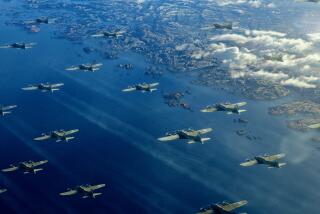Spirits Can Soar in These Model Relationships
In the canyons time forgot, men come to set their spirits a-flight.
Necks craned, a dozen mostly middle-aged engineers follow their radio-controlled model airplanes as they dance across a blue sky. Each man has paid his yearly dues to soar his toy above the canyons, a kind of modern take on Peter Pan.
The Trabuco Fliersâ clubhouse is nestled in South County, circled by mounds covered with sagebrush and stone. Cracked creek beds border its 41 acres of airfield, where daily from sunup to sundown, at least a few planes are aloft.
âMost people have dreams they can fly,â says Phil Hammel, a wiry, bespectacled man from Mission Viejo. âIt feels like a spiritual release, or an ascension. I think this hobby has that in it, because youâre controlling something that leaves the earth.â
Come weekends, a convoy of SUVs groans over the rocks on an S-curled mile of dirt road. As you come past the warped fence topped with barbed wire, you might spot a rattlesnake or mountain lion. The airfield and its clubhouse pop up from the dirt suddenly.
For 17 years, theyâve flown in these canyons, says Bruce Moore, who spends as much time at the club as some folks do at part-time jobs. See the ridge over there? He points: Thatâs where we used to fly. After the first three years, homes went up. We moved here.
Moore sweeps his arm toward the runway: 467 feet of gray from start to stop, ringing five blue-and-yellow flight boxes, each built for one man to stand in while his plane hurtles toward the sun. The club leases the land from a former flier. The 5-pound planes are painted in primary colors.
Their owners chomp on cigars and sip bottled water. Thereâs a clubhouse, with airplane-dotted curtains. The guys razz one another and sometimes swear, though each utterance of a particular word costs a dollar. So far, theyâve stashed about $220 in an account; they might have a party with it someday, they say.
If you come at noon, prime flying time, youâll hear a vroom. Then another. Like gymnasts, tiny planes tumble through the sky, arcing and spinning. They whir like a lawnmower. They land like a cat.
Mostly.
Gerald Heldâs Super Decathlon pinwheels into sagebrush. Oh! the men groan, as if their home-team quarterback just got pummeled. âHow many think it was pilot error?â one man calls. All dozen or so raise their hands.
Jerry, as the nametags pinned to his fishermanâs hat call him, tromps through sage, black trash bag in hand, Hammel at his side. They spot the plane -- red with white stripes and a wingspan that stands as tall as a man. Cost about $800, Held says. Flown it since Christmas.
Held clutches its tail, lets its guts tumble out. Its nose is punched in, like a boxerâs. âIâm just gonna get another plane,â he says. âSometimes, thatâs the best thing. You can fly again fasterâ than if you try to repair the damage.
At one of the stands, Jeff Benefiel, a mortgage banker from Rancho Santa Margarita, fishes through his box of tiny, model-friendly tools. The relationship of man to plane -- he pauses to think -- is like man to pet. This puppy mirrors an old crop duster, like the ones used to train World War II pilots.
Benefiel absently taps the red helmet of the toy pilot inside. âWhen you crash, you get pretty heartbroken,â he says.
Moore, a back-slapping retiree who worked in the aerospace industry, remembers gliders youâd toss to fly. His first radio plane: a red-and-white Cessna 172. Forty years of flight, and still with a new plane, âthe first time you take off, your knees are going bang, bang, bang.â
Why? Each plane has a date, the men say, like when milk expires. Only you donât know when itâs coming. Even the resident kid, flying only a few years, gets it: âYouâre doinâ a bunch of crazy things with a $700 piece of wood,â says Robert Glass, a round-faced 16-year-old.
Some planes disappear in a grove of trees over the hills -- the Trabuco Triangle, itâs called. Some tango with the power lines after a flight filled with hot-dogginâ. Some skid on the runway or collide with each other like speeding traffic.
As one man tried to start his plane, its wooden propeller slammed into his finger, taking a bite out of the propeller and smearing his hand with blood. Might be broken, the guys say. The man reassures them before a friend drives him to the doctor: âIâll probably be back later today.â
Meanwhile, Held sifts through the remains of his crash, breaking off the tail for the boneyard. Four tails spring out of its mound of dirt. (There were more, blown away when the winter winds roared.) One, silver with a black star, was once attached to a plane that cost nearly $2,000 and died on its fifth flight. Held adds his: no tears or mourning, just a last slop of dust.
The sky is clear. Another plane takes flight. Heads tip back.
Hammel says thatâs how things go in the canyon: âWhen your plane takes off, you take off with it.â
More to Read
Sign up for The Wild
Weâll help you find the best places to hike, bike and run, as well as the perfect silent spots for meditation and yoga.
You may occasionally receive promotional content from the Los Angeles Times.






